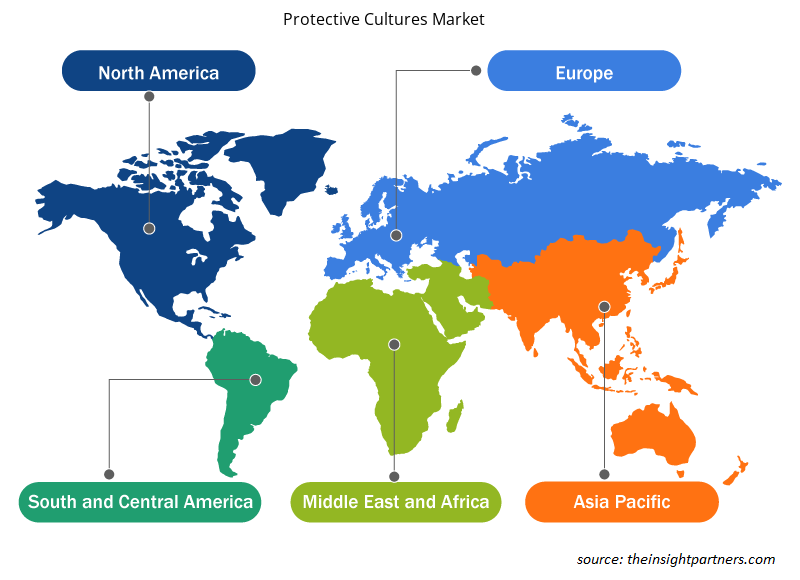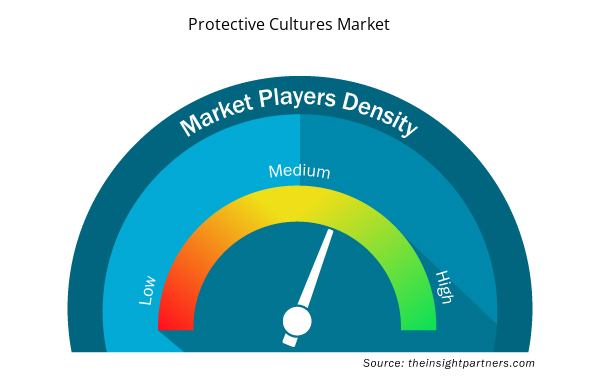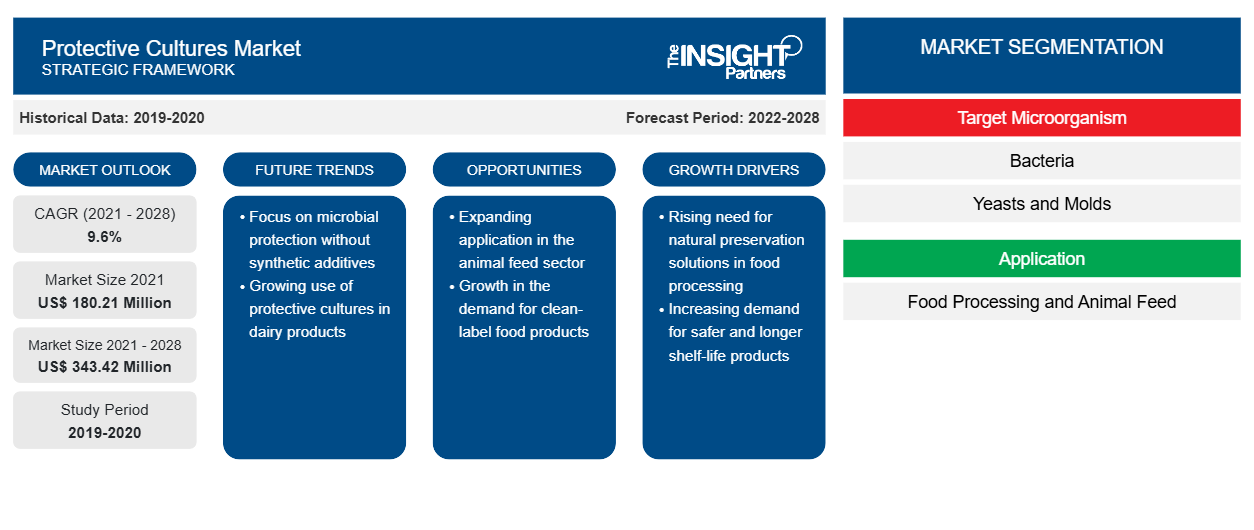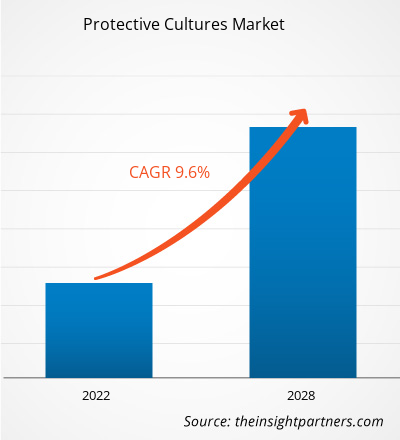[تقرير بحثي] من المتوقع أن ينمو سوق الثقافات الوقائية من 180.21 مليون دولار أمريكي في عام 2021 إلى 343.42 مليون دولار أمريكي بحلول عام 2028؛ ومن المتوقع أن ينمو بمعدل نمو سنوي مركب قدره 9.6٪ من عام 2021 إلى عام 2028.
إن الطلب المتزايد على المنتجات الطبيعية والخالية من المواد الحافظة الكيميائية والطلب المتزايد على المنتجات القابلة للتلف ذات مدة الصلاحية الممتدة في جميع أنحاء العالم يدفع نمو سوق الثقافات الوقائية.
من المتوقع أن ينمو سوق الثقافات الوقائية في منطقة آسيا والمحيط الهادئ بأعلى معدل نمو سنوي مركب خلال الفترة المتوقعة. تعد الصين أهم سوق لمنتجات الألبان ويرجع ذلك أساسًا إلى الاستهلاك المتزايد لمنتجات الألبان. إن الطلب المتزايد على منتجات الألبان مثل الوجبات الخفيفة الطبيعية ومنتجات الألبان المخمرة مثل الحليب الرائب والزبادي إلى جانب ابتكارات المنتجات والتغليف يدفع نمو سوق منتجات الألبان في منطقة آسيا والمحيط الهادئ. لذلك، من المتوقع أن يشهد سوق الثقافات الوقائية نموًا كبيرًا في السنوات القادمة بسبب الاستهلاك المتزايد لمنتجات الألبان وفوائد الثقافات الوقائية، مثل القدرة على منع نمو الكائنات الحية الدقيقة المسببة للأمراض والمفسدة. علاوة على ذلك، فإن زيادة الوعي بالمنتجات الطبيعية والنظيفة بين السكان الآسيويين يساعد لاحقًا في توسيع السوق.
قم بتخصيص هذا التقرير ليناسب متطلباتك
ستحصل على تخصيص لأي تقرير - مجانًا - بما في ذلك أجزاء من هذا التقرير، أو تحليل على مستوى الدولة، وحزمة بيانات Excel، بالإضافة إلى الاستفادة من العروض والخصومات الرائعة للشركات الناشئة والجامعات
- احصل على أهم اتجاهات السوق الرئيسية لهذا التقرير.ستتضمن هذه العينة المجانية تحليلاً للبيانات، بدءًا من اتجاهات السوق وحتى التقديرات والتوقعات.
تأثير جائحة كوفيد-19 على سوق الثقافات الوقائية
كان لجائحة كوفيد-19 المستمرة تأثير إيجابي نسبيًا على سوق الثقافات الوقائية. فقد ساعدت الجائحة في تطوير الاهتمام والوعي فيما يتعلق بالثقافات الميكروبية. كانت الأزمة وقتًا مزعجًا ومجهدًا لمعظم السكان في جميع أنحاء العالم. لذلك، بدأ الناس في جميع أنحاء العالم في استهلاك المنتجات ذات العلامة النظيفة. بعد ظهور جائحة كوفيد-19، أصبح الناس أكثر حذرًا فيما يتعلق بالطعام ويستهلكون طعامًا أكثر صحة من النظام الغذائي المعتاد. لقد غيرت جائحة كوفيد-19 تصور المستهلك للنظافة بما يتجاوز الملصقات أو المنتجات. يواصل المستهلكون الحفاظ على تركيزهم على العلامة النظيفة للمشتريات في المنزل وخارجه، مما يزيد من تطبيق العلامة النظيفة في تطبيقات الأغذية المختلفة. علاوة على ذلك، فإن آفاق التقدم الاقتصادي في معظم البلدان متفائلة لعام 2021.
رؤى السوق
زيادة استهلاك منتجات الألبان
تتطور سوق الألبان في جميع أنحاء العالم. يفضل المستهلكون منتجات الألبان الطبيعية والمستدامة والأفضل بالنسبة لهم مع قوائم مكونات أقصر وشفافية أفضل في وضع العلامات على المنتجات. مع أنماط الحياة الحديثة المزدحمة المتنامية، هناك طلب متزايد على الخيارات المريحة التي يمكن استهلاكها أثناء التنقل دون الحاجة إلى تبريدها لتظل طازجة. تعد الثقافات الوقائية مهمة في دعم مصنعي الألبان لإضافة المزيد إلى صافي أرباحهم من خلال تجنب التلف طوال فترة الصلاحية، وبالتالي تلبية احتياجات المستهلكين للمنتجات الطبيعية والنظيفة. علاوة على ذلك، فإن استهلاك منتجات الألبان، مثل الزبادي والزبدة والجبن، يتزايد في جميع أنحاء العالم.
أصبح الجبن مكونًا أساسيًا في الأنظمة الغذائية اليومية في جميع أنحاء العالم. وفقًا لوزارة الزراعة في الولايات المتحدة، تم إنتاج 5733 طنًا متريًا من الجبن في البلاد في عام 2017، ويستهلك الأشخاص في أمريكا الشمالية في المتوسط حوالي 6626 طنًا متريًا من الجبن سنويًا. كما تعد سوق الجبن واحدة من المستخدمين النهائيين الرئيسيين للثقافات الوقائية بسبب الثقافة الوقائية المحددة المستخدمة ضد الليستيريا. وهي مصنوعة من Lactobacillus plantarum وهي فعالة في منع الليستيريا من التكون على أسطح الجبن الناضجة عالية الخطورة ذات اللون الأحمر. ومن الآن فصاعدًا، تدفع العوامل المذكورة أعلاه الطلب على الجبن في سوق الثقافات الوقائية. علاوة على ذلك، تتمتع شركات مثل DuPont Danisco وChr Hansen بحضور كبير في سوق منتجات الألبان مع ثقافات وقائية واسعة النطاق للألبان. مع الطلب المتزايد على منتجات الألبان الطبيعية والصحية، تشهد المنتجات ذات العلامة النظيفة والعلامة الخضراء طلبًا كبيرًا في صناعة الألبان.
رؤى الكائنات الحية الدقيقة المستهدفة
بناءً على الكائنات الحية الدقيقة المستهدفة، ينقسم سوق الثقافات الوقائية إلى البكتيريا والخميرة والعفن. شكلت شريحة الخميرة والعفن حصة سوقية أكبر في عام 2020. الخميرة هي مجموعة فرعية من الفطريات، وهي مجموعة كبيرة من الكائنات الحية التي تشمل أيضًا العفن والفطر. وهي عادةً كائنات وحيدة الخلية تطورت لتعيش في بيئة متخصصة. تستعمر الخميرة عادةً الأطعمة عالية الملح أو عالية السكر، مثل المخللات وشراب القيقب وغيرها، مما يساهم في تدهورها. الفواكه والسوائل ذات الرقم الهيدروجيني المنخفض هي أهداف أخرى، وهناك بعض الخميرة التي تتطور على أسطح اللحوم والجبن. تتكون العفن من ملايين الخلايا المجهرية التي ترتبط معًا لتكوين سلاسل ويمكن العثور عليها على الخبز والفواكه والورق الرطب وغيرها من الأسطح. يمكنها إفساد الأطعمة الجافة والأسماك المملحة والفواكه والهلام والخبز والمخللات والمربى وغيرها من المنتجات المماثلة.
رؤى التطبيق
بناءً على التطبيق، ينقسم سوق الثقافات الوقائية إلى معالجة الأغذية والأعلاف الحيوانية. استحوذ قطاع معالجة الأغذية على حصة سوقية أكبر في عام 2020، في حين من المتوقع أن يسجل قطاع الأعلاف الحيوانية معدل نمو سنوي مركب أعلى في السوق خلال فترة التوقعات. تشمل معالجة الأغذية صناعات مختلفة مثل منتجات الألبان؛ المشروبات؛ ومنتجات اللحوم والدواجن والمأكولات البحرية. هناك استخدام متزايد للثقافات الوقائية، وخاصة في صناعات الألبان واللحوم والمأكولات البحرية، حيث يتم الاعتراف بها عمومًا على أنها آمنة (GRAS) للاستهلاك وتسود بشكل طبيعي في ميكروبات العديد من الأطعمة. بالإضافة إلى ذلك، نظرًا للحاجة إلى منتجات ذات عمر تخزين أطول، يستخدم مصنعو الأغذية بشكل متزايد الثقافات الوقائية. بالإضافة إلى ذلك، أصبح المستهلكون يدركون أن كمية كبيرة من هدر الطعام ناتجة عن التلف ونمو العفن. وهذا يؤثر أيضًا على ربحية مصنعي الأغذية؛ وبالتالي، يستخدم المصنعون الثقافات الوقائية للحد من هدر الطعام. لذلك، يتزايد الطلب على هذه المنتجات في صناعة الأغذية. تعتبر الثقافات الوقائية ذات أهمية بالغة في مساعدة منتجي الألبان على تحسين منتجاتهم من خلال تجنب التلف طوال فترة الصلاحية، وتمديد فترة الصلاحية مع تلبية طلب المستهلكين على المنتجات الطبيعية والأكثر نظافة.
هناك عدد قليل من اللاعبين الذين يعملون في سوق الثقافات الوقائية وهم Biochem Srl وBioprox وChr. Hansen Holding A/S وMeat Cracks Technologie GmbH وDSM وLallemand Inc. وInternational Flavors & Fragrances Inc. وKerry Group وSacco System وDalton Biotechnologies Srl. تتبنى الشركات الرئيسية استراتيجيات مثل عمليات الدمج والاستحواذ والبحث والتطوير لتوسيع قاعدة العملاء والحصول على حصة كبيرة في السوق العالمية، مما يسمح لها أيضًا بالحفاظ على اسم علامتها التجارية عالميًا.
رؤى إقليمية حول سوق الثقافات الوقائية
لقد قام المحللون في Insight Partners بشرح الاتجاهات والعوامل الإقليمية المؤثرة على سوق الثقافات الوقائية طوال فترة التوقعات بشكل شامل. يناقش هذا القسم أيضًا قطاعات سوق الثقافات الوقائية والجغرافيا في جميع أنحاء أمريكا الشمالية وأوروبا ومنطقة آسيا والمحيط الهادئ والشرق الأوسط وأفريقيا وأمريكا الجنوبية والوسطى.

- احصل على البيانات الإقليمية المحددة لسوق الثقافات الوقائية
نطاق تقرير سوق الثقافات الوقائية
| سمة التقرير | تفاصيل |
|---|---|
| حجم السوق في عام 2021 | 180.21 مليون دولار أمريكي |
| حجم السوق بحلول عام 2028 | 343.42 مليون دولار أمريكي |
| معدل النمو السنوي المركب العالمي (2021 - 2028) | 9.6% |
| البيانات التاريخية | 2019-2020 |
| فترة التنبؤ | 2022-2028 |
| القطاعات المغطاة | حسب الكائن الحي المستهدف
|
| المناطق والدول المغطاة | أمريكا الشمالية
|
| قادة السوق وملفات تعريف الشركات الرئيسية |
|
كثافة اللاعبين في سوق الثقافات الوقائية: فهم تأثيرها على ديناميكيات الأعمال
يشهد سوق الثقافات الوقائية نموًا سريعًا، مدفوعًا بالطلب المتزايد من المستخدم النهائي بسبب عوامل مثل تفضيلات المستهلك المتطورة والتقدم التكنولوجي والوعي المتزايد بفوائد المنتج. ومع ارتفاع الطلب، تعمل الشركات على توسيع عروضها والابتكار لتلبية احتياجات المستهلكين والاستفادة من الاتجاهات الناشئة، مما يؤدي إلى زيادة نمو السوق.
تشير كثافة اللاعبين في السوق إلى توزيع الشركات أو المؤسسات العاملة في سوق أو صناعة معينة. وهي تشير إلى عدد المنافسين (اللاعبين في السوق) الموجودين في مساحة سوق معينة نسبة إلى حجمها أو قيمتها السوقية الإجمالية.
الشركات الرئيسية العاملة في سوق الثقافات الوقائية هي:
- شركة بيوكيم المحدودة
- بيوبروكس
- شركة كر. هانسن القابضة
- شركة Meat Cracks Technologie GmbH
- التشخيصات والإحصائيات للأمراض النفسية
إخلاء المسؤولية : الشركات المذكورة أعلاه ليست مرتبة بأي ترتيب معين.

- احصل على نظرة عامة على أهم اللاعبين الرئيسيين في سوق الثقافات الوقائية
تقرير يسلط الضوء على
- اتجاهات الصناعة التقدمية في سوق الثقافات الوقائية لمساعدة اللاعبين على تطوير استراتيجيات فعالة طويلة الأجل
- استراتيجيات نمو الأعمال التي تتبناها الأسواق المتقدمة والنامية
- التحليل الكمي لسوق الثقافات الوقائية من 2019 إلى 2028
- تقدير الطلب العالمي على الثقافة الوقائية
- تحليل القوى الخمس لبورتر
- التطورات الأخيرة لفهم سيناريو السوق التنافسي
- اتجاهات السوق وتوقعاته بالإضافة إلى العوامل التي تدفع وتكبح نمو سوق الثقافات الوقائية
- المساعدة في عملية اتخاذ القرار من خلال تسليط الضوء على استراتيجيات السوق التي تدعم المصلحة التجارية، مما يؤدي إلى نمو السوق
- حجم سوق الثقافات الوقائية في العقد المختلفة
- نظرة عامة مفصلة وتقسيم السوق، بالإضافة إلى ديناميكيات صناعة الثقافة الوقائية
- حجم سوق الثقافات الوقائية في مختلف المناطق مع فرص نمو واعدة
سوق الثقافات الوقائية – حسب الكائنات الحية الدقيقة المستهدفة
- البكتيريا
- الخميرة والعفن
سوق الثقافات الوقائية – حسب التطبيق
- معالجة الأغذية
- منتجات الألبان
- المشروبات
- منتجات اللحوم والدواجن والمأكولات البحرية
- آحرون
- علف الحيوانات
نبذة عن الشركة
- شركة بيوكيم المحدودة
- بيوبروكس
- شركة كر. هانسن القابضة
- شركة Meat Cracks Technologie GmbH
- التشخيصات والإحصائيات للأمراض النفسية
- شركة لالماند
- الشركة العالمية للنكهات والعطور
- مجموعة كيري
- نظام ساكو
- شركة دالتون للتكنولوجيا الحيوية
- التحليل التاريخي (سنتان)، السنة الأساسية، التوقعات (7 سنوات) مع معدل النمو السنوي المركب
- تحليل PEST و SWOT
- حجم السوق والقيمة / الحجم - عالميًا وإقليميًا وقطريًا
- الصناعة والمنافسة
- مجموعة بيانات Excel


- Vision Guided Robotics Software Market
- Visualization and 3D Rendering Software Market
- Intradermal Injection Market
- Hydrocephalus Shunts Market
- Pressure Vessel Composite Materials Market
- Fish Protein Hydrolysate Market
- Vertical Farming Crops Market
- Clinical Trial Supplies Market
- Online Recruitment Market
- Procedure Trays Market

Report Coverage
Revenue forecast, Company Analysis, Industry landscape, Growth factors, and Trends

Segment Covered
This text is related
to segments covered.

Regional Scope
North America, Europe, Asia Pacific, Middle East & Africa, South & Central America

Country Scope
This text is related
to country scope.
الأسئلة الشائعة
By application, the global protective cultures market is bifurcated into food processing and animal feed. The food processing segment is further bifurcated into dairy products; beverages; meat, poultry, & seafood products; and others. The food processing segment dominated the market in 2020 and is expected to maintain its dominance throughout the forecast period. However, the animal feed segment is expected to register a higher growth rate during the forecast period 2021–2028.
The overall threat of rivalry in protective culture market is high. Rivalry is considered to be a high threat to profit when there are more than two competitors of similar size. Herein, competitive rivalry is intense as the industry’s products are more or less undifferentiated. This makes for intense rivalry because competitors are constantly seeking ways to reach a competitive advantage over one another to gain market share. Moreover, all the market players compete on the basis of cost, product quality, and after sales service to name a few.
The global protective cultures market growth is majorly influenced by determinants such as rising demand for dairy products, increasing adoption of natural preservatives, rising focus on reducing food wastage.
In 2020, Europe accounted for the largest share in the global protective cultures market. Europe is amongst the largest markets for protective cultures owing to the well-established dairy industry, rising adoption of various food safety trends, and growing innovations across the food & beverages sector in the region. Consumers across Europe prefer natural, organic, and sustainable dairy products that are minimally processed and contain simple ingredients. In addition, transparent product labelling helps health-conscious consumers across the region have a better knowledge of the components utilized in dairy products. Therefore, dairy manufacturers are incorporating protective cultures, which are specialized bacteria, to inhibit the growth of pathogenic organisms or microbiological deterioration agents.
The major players operating in the global protective cultures market are Biochem Srl, Bioprox, Chr. Hansen Holding A/S, Meat Cracks Technologie GmbH, DSM, Lallemand Inc., International Flavors & Fragrances Inc., Kerry Group, Sacco System, and Dalton Biotechnologies S.r.l.
Based on target microorganism, the protective cultures market is segmented into bacteria, and yeasts & molds. The yeasts & molds segment held a larger share in the global protective cultures market in 2020. Yeast and molds are two of the most important contaminants that impact food quality. The use of a protective culture helps reduce wastage and spoilage caused by these microbes. Yeast typically colonizes on high-salt or high-sugar foods, such as pickles, maple syrup, and others, which contribute to their deterioration. Fruits and liquids with a low pH are other targets, and there are some yeasts that develop on the surfaces of meat and cheese.
Trends and growth analysis reports related to Food and Beverages : READ MORE..
The List of Companies - Protective Cultures Market
- Biochem Srl
- Bioprox
- Chr. Hansen Holding A/S
- Meat Cracks Technologie GmbH
- DSM
- Lallemand Inc.
- International Flavors & Fragrances Inc.
- Kerry Group
- Sacco System
- Dalton Biotechnologies S.r.l
The Insight Partners performs research in 4 major stages: Data Collection & Secondary Research, Primary Research, Data Analysis and Data Triangulation & Final Review.
- Data Collection and Secondary Research:
As a market research and consulting firm operating from a decade, we have published and advised several client across the globe. First step for any study will start with an assessment of currently available data and insights from existing reports. Further, historical and current market information is collected from Investor Presentations, Annual Reports, SEC Filings, etc., and other information related to company’s performance and market positioning are gathered from Paid Databases (Factiva, Hoovers, and Reuters) and various other publications available in public domain.
Several associations trade associates, technical forums, institutes, societies and organization are accessed to gain technical as well as market related insights through their publications such as research papers, blogs and press releases related to the studies are referred to get cues about the market. Further, white papers, journals, magazines, and other news articles published in last 3 years are scrutinized and analyzed to understand the current market trends.
- Primary Research:
The primarily interview analysis comprise of data obtained from industry participants interview and answers to survey questions gathered by in-house primary team.
For primary research, interviews are conducted with industry experts/CEOs/Marketing Managers/VPs/Subject Matter Experts from both demand and supply side to get a 360-degree view of the market. The primary team conducts several interviews based on the complexity of the markets to understand the various market trends and dynamics which makes research more credible and precise.
A typical research interview fulfils the following functions:
- Provides first-hand information on the market size, market trends, growth trends, competitive landscape, and outlook
- Validates and strengthens in-house secondary research findings
- Develops the analysis team’s expertise and market understanding
Primary research involves email interactions and telephone interviews for each market, category, segment, and sub-segment across geographies. The participants who typically take part in such a process include, but are not limited to:
- Industry participants: VPs, business development managers, market intelligence managers and national sales managers
- Outside experts: Valuation experts, research analysts and key opinion leaders specializing in the electronics and semiconductor industry.
Below is the breakup of our primary respondents by company, designation, and region:

Once we receive the confirmation from primary research sources or primary respondents, we finalize the base year market estimation and forecast the data as per the macroeconomic and microeconomic factors assessed during data collection.
- Data Analysis:
Once data is validated through both secondary as well as primary respondents, we finalize the market estimations by hypothesis formulation and factor analysis at regional and country level.
- Macro-Economic Factor Analysis:
We analyse macroeconomic indicators such the gross domestic product (GDP), increase in the demand for goods and services across industries, technological advancement, regional economic growth, governmental policies, the influence of COVID-19, PEST analysis, and other aspects. This analysis aids in setting benchmarks for various nations/regions and approximating market splits. Additionally, the general trend of the aforementioned components aid in determining the market's development possibilities.
- Country Level Data:
Various factors that are especially aligned to the country are taken into account to determine the market size for a certain area and country, including the presence of vendors, such as headquarters and offices, the country's GDP, demand patterns, and industry growth. To comprehend the market dynamics for the nation, a number of growth variables, inhibitors, application areas, and current market trends are researched. The aforementioned elements aid in determining the country's overall market's growth potential.
- Company Profile:
The “Table of Contents” is formulated by listing and analyzing more than 25 - 30 companies operating in the market ecosystem across geographies. However, we profile only 10 companies as a standard practice in our syndicate reports. These 10 companies comprise leading, emerging, and regional players. Nonetheless, our analysis is not restricted to the 10 listed companies, we also analyze other companies present in the market to develop a holistic view and understand the prevailing trends. The “Company Profiles” section in the report covers key facts, business description, products & services, financial information, SWOT analysis, and key developments. The financial information presented is extracted from the annual reports and official documents of the publicly listed companies. Upon collecting the information for the sections of respective companies, we verify them via various primary sources and then compile the data in respective company profiles. The company level information helps us in deriving the base number as well as in forecasting the market size.
- Developing Base Number:
Aggregation of sales statistics (2020-2022) and macro-economic factor, and other secondary and primary research insights are utilized to arrive at base number and related market shares for 2022. The data gaps are identified in this step and relevant market data is analyzed, collected from paid primary interviews or databases. On finalizing the base year market size, forecasts are developed on the basis of macro-economic, industry and market growth factors and company level analysis.
- Data Triangulation and Final Review:
The market findings and base year market size calculations are validated from supply as well as demand side. Demand side validations are based on macro-economic factor analysis and benchmarks for respective regions and countries. In case of supply side validations, revenues of major companies are estimated (in case not available) based on industry benchmark, approximate number of employees, product portfolio, and primary interviews revenues are gathered. Further revenue from target product/service segment is assessed to avoid overshooting of market statistics. In case of heavy deviations between supply and demand side values, all thes steps are repeated to achieve synchronization.
We follow an iterative model, wherein we share our research findings with Subject Matter Experts (SME’s) and Key Opinion Leaders (KOLs) until consensus view of the market is not formulated – this model negates any drastic deviation in the opinions of experts. Only validated and universally acceptable research findings are quoted in our reports.
We have important check points that we use to validate our research findings – which we call – data triangulation, where we validate the information, we generate from secondary sources with primary interviews and then we re-validate with our internal data bases and Subject matter experts. This comprehensive model enables us to deliver high quality, reliable data in shortest possible time.


 احصل على عينة مجانية لهذا التقرير
احصل على عينة مجانية لهذا التقرير